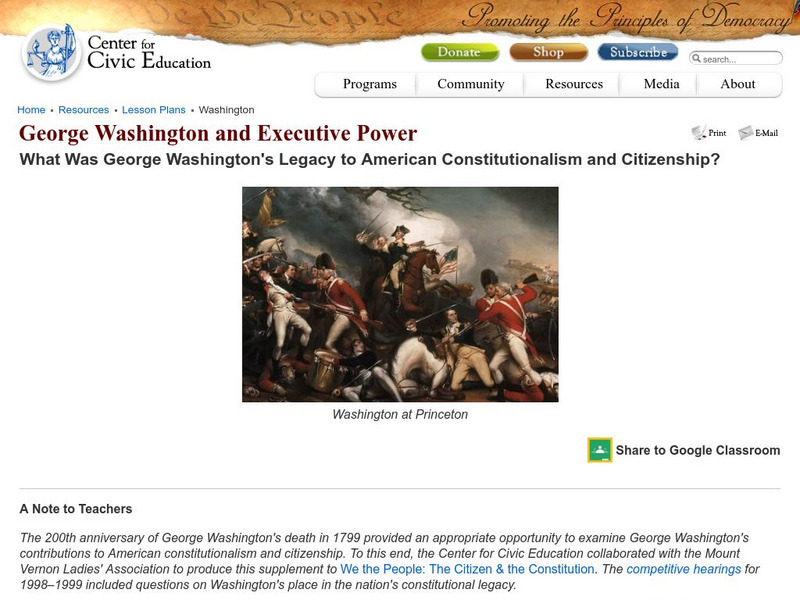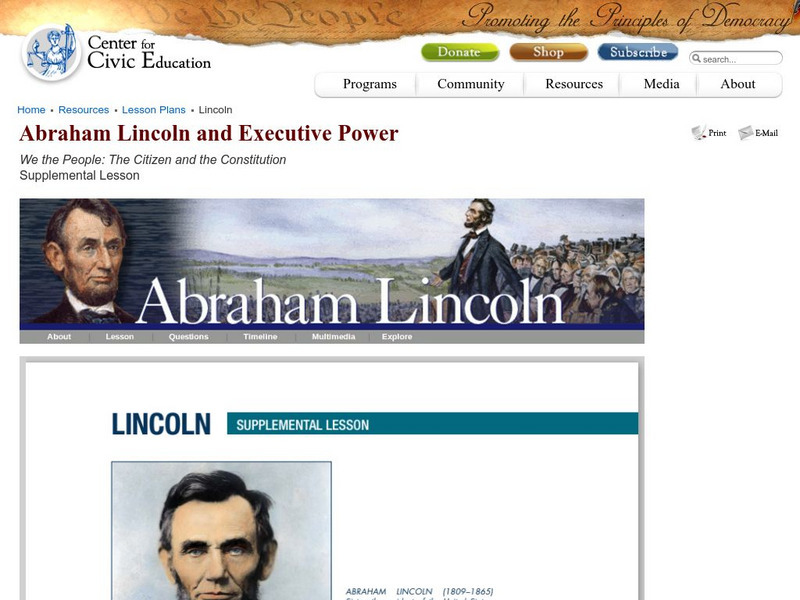Curated OER
Senate Confirmation Hearings on Cabinet
Students explain the confirmation process of presidential nominees to the Cabinet. They compose a list of questions to ask at a conformation hearing.
Curated OER
Sow the Seeds of Victory! Posters from the Food Administration During World War I
High schoolers engage in a class analysis of posters, responding to each of the worksheet questions. They identify the similarities and differences between the posters.
Curated OER
The Formation and Function of the Supreme Court
Students analyze the role of the U.S. Supreme Court. They read a handout and Article III, section 1 of the Constitution, analyze and rate by relevance noteworthy Supreme Court cases, and write how they decided each rating.
Curated OER
Civil War in Nigeria
Students view Powerpoint on Nigerian conflict, listen to and discuss Recruitment Speech and Flyers of Weke Okujagu, and complete vocabulary and critical thinking worksheets as a class.
Curated OER
Exploring the Three Branches of Government
Students view a PowerPoint presentation to explore the three branches of government. Using this infromation, they identify the people, buildings and responsiblities of each branch. They complete a worksheet using the internet and take a...
Curated OER
People Behind the Masks
Fourth graders are introduced to the art of mask making. They develop understanding of the world cultures that have produced the masks. They utilize a worksheet imbedded in this plan to help guide their study.
Curated OER
Hyperlinking the Hill
Students explain the parts and process of parliamentary democracy. Working students create a word document on the aspect of parliamentary democracy that they have been assigned.
Curated OER
Personal History
Fourth graders gain an appreciation of knowledge about recent history by interviewing senior citizens. They summarize their interviews and organize them into a written presentation.
Curated OER
Capitol vs. Capital
Students construct time lines to show the order of significant events in Ohio history. They explain how Ohio progressed from territory to statehood.
Curated OER
Helmet Safety/ Travis's Story
Fourth graders investigate the concept of walking and riding a bicycle as necessary forms of transportation. They watch a video about bicycle safety and write a reflection about notes taken from the video. Students conduct an experiment...
Curated OER
Houghton Mifflin Social Studies/Chapter 13, Lesson 2 California Fights Smog (pp. 296-300)
Third graders look into certain environmental problems. The governmental branches are investigated and how government takes care to solve problems of the environment.
Curated OER
Michigan Constitution and the Legislative Branch
Students explore online resources to compare and contrast the different constitutions the state of Michigan has had. They continue their exploration of various websites, focusing on the legistlative branch and the homepage of their local...
Curated OER
Views And voices From Within
Students investigate the life and artwork of Estelle Ishigo. They use a timeline and primary sources in order to understand the influence of living in a relocation camp during World War II. The lesson includes an extensive historical...
Curated OER
Social Studies: Exploring Japan
Fourth graders examine the culture and environment of Japan, beginning with a KWL chart. They use clay and cups of water to construct representations of the Japanese Islands. After designing flags representing farming and food, 4th...
Curated OER
Creating a School Web Site
Students create websites for their school. They work in groups as a web team and devise a self-management plan. As they work on projects reflecting school life, the team edits what may appear online as the school's web site. Writing...
Curated OER
Trial of King Charles
In this King Charles worksheet, students read about the facts of the trial of King Charles. Students also learn the characters who took part in the trial.
Curated OER
A CONSTITUTIONAL CONVENTION: A SIMULATION
Students discuss two computerized options to change the current U.S. government. In this Constitutional Convention instructional activity, students write a statement advocating for one of the choices and participate in a mock modern...
Curated OER
The Articles of Confederation
In this Articles of Confederation instructional activity, students fill in blanks in an outline about the Articles. No text reference is given.
Curated OER
J’adore Blackpool, Chuck*: YouTube Lures the French to the British Seaside Resort
Ninth graders explore the British seaside resort Blackpool. In this British Travel ESL lesson, 9th graders read an article and answer guided reading questions. Students create a short story about what a person did in Blackpool.
Center For Civic Education
Center for Civic Education: Ronald Reagan and Executive Power [Pdf]
"Ronald Reagan and Executive Power" examines the use of presidential powers by Ronald Reagan, the fortieth president of the United States. It explores Article II of the Constitution, which grants the president executive powers.
Center For Civic Education
Center for Civic Education: Ronald Reagan and Executive Power
This site is a comprehensive examination of Ronald Reagan's administration and how he used his executive powers. It looks at his policies and his ongoing legacy. Includes videos, historical context, and lesson plans from elementary up.
Center For Civic Education
Center for Civic Education: George Washington and Executive Power
This activity looks at the legacy of George Washington, perhaps the most influential leader in the creation of the American nation. Through his achievements as commander-in-chief during the Revolution, in support of the drafting and...
Center For Civic Education
Center for Civic Education: Abraham Lincoln and Executive Power
This activity traces the rise of Abraham Lincoln from his humble beginnings to the presidency of the United States. You will examine Lincoln's ideas and decisions regarding slavery and the use of the presidential power to preserve the...




















![Center for Civic Education: Ronald Reagan and Executive Power [Pdf] Lesson Plan Center for Civic Education: Ronald Reagan and Executive Power [Pdf] Lesson Plan](https://static.lp.lexp.cloud/images/attachment_defaults/resource/large/FPO-knovation.png)

